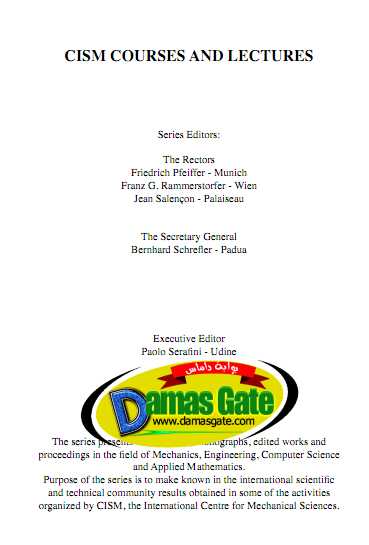Exploiting Nonlinear Behavior in Structural Dynamics

CISM COURSES AND LECTURES
Series Editors:
The Rectors
Friedrich Pfeiffer - Munich
Franz G. Rammerstorfer - Wien
Jean Salençon - Palaiseau
The Secretary General
Executive Editor
The series presents lecture notes, monographs, edited works and
and Applied Mathematics.
and technical community results obtained in some of the activities
1 Introduction
The presence of nonlinearity in a dynamic system is often viewed as undesirable
and historically the emphasis has been to design systems ensuring
that nonlinear behaviour regimes are avoided. However, with ever more
ambitious design envelopes it is becoming more common for structures to
behave nonlinearly. This nonlinearity may be a consequence of pushing existing
design solutions beyond their linear limit. Increasingly however, it
is because of engineers deliberately designing a structure to have nonlinear
dynamic properties. The motivaton being to exploit some characteristic of
the nonlinear dynamic response to maximise the structure’s performance
envelope. One example of this is the design of passive vibration suppression
systems for buildings. It has been reported that nonlinear devices, such
as tuned-mass dampers with nonlinear stiffness characteristics, can operate
effectively over far wider frequency ranges than the equivalent linear devices
(see, for example, Soong and Dargush, 1997 or Reed et al., 1998).
Download
http://s18.alxa.net/s18/srvs2/02/001...l.Dynamics.rar

CISM COURSES AND LECTURES
Series Editors:
The Rectors
Friedrich Pfeiffer - Munich
Franz G. Rammerstorfer - Wien
Jean Salençon - Palaiseau
The Secretary General
Executive Editor
The series presents lecture notes, monographs, edited works and
and Applied Mathematics.
and technical community results obtained in some of the activities
1 Introduction
The presence of nonlinearity in a dynamic system is often viewed as undesirable
and historically the emphasis has been to design systems ensuring
that nonlinear behaviour regimes are avoided. However, with ever more
ambitious design envelopes it is becoming more common for structures to
behave nonlinearly. This nonlinearity may be a consequence of pushing existing
design solutions beyond their linear limit. Increasingly however, it
is because of engineers deliberately designing a structure to have nonlinear
dynamic properties. The motivaton being to exploit some characteristic of
the nonlinear dynamic response to maximise the structure’s performance
envelope. One example of this is the design of passive vibration suppression
systems for buildings. It has been reported that nonlinear devices, such
as tuned-mass dampers with nonlinear stiffness characteristics, can operate
effectively over far wider frequency ranges than the equivalent linear devices
(see, for example, Soong and Dargush, 1997 or Reed et al., 1998).
Download
http://s18.alxa.net/s18/srvs2/02/001...l.Dynamics.rar